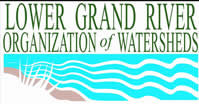Lower Grand Watershed Interactive Tool (WIT) - Hydrologic Flow

FYI on Local Water Issues
Hydrologic flow function - when the natural hydrology of the watershed changes due to increase in storm water runoff.
Composition of Stream Flow
Following a rainfall event, the rainwater that reaches the ground surface will infiltrate into soils. Once the rainfall intensity exceeds the infiltration capacity, surface runoff may occur. Generally, a large watershed consists of a number of subbasins. The overland flow in a subbasin converges at a certain point (outlet) and finally flows into the main river channel through the stream network of the watershed. For the infiltrating water, a portion of it may flow laterally in the shallow, saturated soil and directly discharge into the stream channel (interflow) while the remaining water may percolate down through the soil profile and reach the underlying aquifer. Under certain hydrogeological conditions, the groundwater may also discharge to an adjacent river/stream (baseflow). Thus, stream flow comes from two major components: direct runoff and baseflow.
Variability of Stream Flow
Stream flow changes in both time and space. Peaks of stream flow are commonly dominated by direct runoff resulting from highly intense rainfall. On the other hand, the relatively stable baseflow sustains the stream flow during dry time periods without rainfall. Baseflow can be a significant water source of a river/stream. It often contributes more than 50% of water discharges for many rivers in West Michigan. Following a rainfall event, peak flow can be observed at the outlet of a small watershed in a couple of hours. For a large watershed, however, it may take many days for a peak to arrive at the outlet of the watershed.
Factors Affecting Stream Flow
The magnitude and timing of runoff can be affected by many factors related to climate, hydrology, hydrogeological settings, vegetation, and human activities, such as rainfall intensity, land use (e.g., plant canopy and impervious area), soil types, and watershed characteristics (e.g., geometric and topographic features). Urban and rural regions in a watershed have distinct hydrologic features, which further lead to various quantity of storm runoff and dissimilar flow pathways. For example, huge surface runoff can be generated in some urban districts due to substantial impervious areas.
Why is this a pollutant?
Huge amounts of surface runoff can carry numerous pollutants into water bodies. Surface runoff can collect oils, fertilizers, soil, animal waste, and trash from the land and deposit in unchecked into streams and rivers. Once the large amount of water enters the stream or river, it can quickly overload it, tearing at the banks, pushing aquatic animals out of their habitat, and destroying bank vegetation; literally blasting the "pipes" clean. This is different from nature's methods of handling stormwater.
In nature, rainfall trickles into the soil, recharging groundwater while pollutants are filtered out through the soil column. The water moves at a slower rate on the surface as it passes through vegetation. The streams/rivers rise less drastically and over a longer period of time. The banks are not stressed as much, the vegetation can better withstand the force of the flow, and wildlife can secure themselves to stream bottoms or swim against the current.
MDEQ Online References
- Introduction to Hydrology
- NPS Hydrologic Analysis
- Stream Stability and Channel Forming Flows
- Hydrologic Impacts Due to Development
Special thanks to Xuefeng Chu, AWRI Hydrologist, for his contribution.
